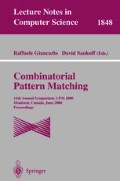Abstract
Computer-graded multiple choice examinations are a familiar and dreaded part of most student’s lives. Many test takers are particularly fearful of form-filling shift errors, where absent-mindedly marking the answer to (say) question 32 in position 31 causes a long run of answers to be successively displaced. Test-taking strategies where students answer questions out of sequence (such as answering easy questions first) seem particularly likely to cause unrecognized shift errors. Such errors can result in many correct answers being marked wrong, and significantly lower the exam taker’s score.
In this paper, we consider the question of whether these shift errors can be accurately recognized and corrected for. Our results suggest that students are right to fear such errors, and that a non-trivial fraction of multiple-choice exams appear to contain significant shift errors. In particular, we found evidence that 1%–2% of multiple-choice exam papers at SUNY Stony Brook contain likely shift errors, each causing the loss of about 10% of the student's grade. Given the importance of standardized examinations, clerical mistakes should not be allowed to have such an impact on the student's score. If our observed shift error rate holds across the millions of examinations given annually, this is a serious but yet unstudied problem. Indeed, based on the preliminary results in the paper, we have begun working with The College Board to study the prevalence of uncorrected shift-errors in SAT examinations.
This work is partially supported by NSF Grant CCR-9625669 and ONR Award N00149710589.
Partially supported by the 1998 GAAN graduate fellowship P200A97030199.
Access this chapter
Tax calculation will be finalised at checkout
Purchases are for personal use only
Preview
Unable to display preview. Download preview PDF.
References
M. G. Aamodt and T. Mcshane. A meta-analytic investigation of the effect of various test item characteristics on test scores and test completion times. Public Personnel Management, 21:151–160, 1992.
W. R. Balch. Item order affects performance on multiple choice exams. Teaching of Psychology, 16:75–77, 1989.
J. A. Bath. Answer-changing behavior on objective examinations. Journal of Educational Research, 61:105–107, 1967.
M. D. Beck. The effect of item response changes on scores on an elementary reading achievement test. Journal of Educational Research, 71:153–156, 1976.
J. L. Carlson and A. L. Ostrosky. Item sequence and student performance on multiple choice exams-further evidence. Journal of Economic Education, 23:232–235, 1992.
C. A. Clark. Should students change answers on objective tests? Chicago Schools Journal, 43:382–385, 1962.
D. A. Copeland. Should chemistry students change answers on multiple-choice tests? Journal chemical Education, 49:258, 1972.
V. Dancik. Expected length of Longest Common Subsequences. PhD thesis, University of Warwik, Warwick, UK, 1994.
K. A. Edwards and C. Marshall. First impressions on tests: Some new findings. Teaching Psychology, 4:193–195, 1977.
D. N. Harpp and J. J. Hogan. Crime in the classroom-detection and prevention of cheating on multiple choice exams. Journal of Chemical Education, 70:306–311, 1993.
R. Hertzberg. Vice president of marketing research, scantron. Personal communication, September 1999.
G. E. Hill. The effect of changed responses in true-false tests. Journal of Educational Psychology, 28:308–310, 1937.
NCS Inc. Annual report. World Wide Web, http://www.ncs.edu, September 1999.
S. S. Jacobs. Answer changing on objective tests: Some implications for test validity. Educational and Psychology Measurement, 32:1039–1044, 1972.
R. F Jarrett. The extra-chance nature of changes in students’ responses to objective test items. Journal of General Psychology, 38:243–250, 1948.
E. E. Lamson. What happens when the second judgment is recorded in a true-false test? Journal of Educational Psychology, 26:223–227, 1935.
M. L. Lowe and Crawford. First impressions versus second thought in true-false tests. Journal of Educational psychology, 20:192–195, 1929.
D. O. Lynch and Smith. Item response changes: Effects on test scores. Measurement and Evaluation in Guidance, 7:220–224, 1975.
C. O. Mathews. Erroneous first impressions on objective tests. Journal of Educational Psychology, 20:260–286, 1929.
M. K. Matter. The relationship between achievement test response changes, ethnicity, and family income. PhD thesis, University of Texas, Austin, 1985.
D. J. Mueller and A. Shuedel. Some correlates on net gain resultant from answer changing on objective achievement test items. Journal of Educational Measurement, 12:251–254, 1975.
P. J. Pascale. Changing initial answers on multiple choice achievement tests. Measurement and Evaluation in Guidance, 6:236–238, 1974.
G. Prieto and A. R. Delgado. The effect of instructions on multiple-choice test scores. European Journal of Psychological assessment, 15:143–150, 1999.
P. J. Reile and L. J. Briggs. Should students change their initial answers on objective type tests? more evidence regarding an old problem. Journal of Educational Psychology, 43:110–115, 1952.
E. Reiling and R. Taylor. A new approach to the problem of changing initial responses to multiple choice questions. Journal of Educational Measurement, 9:67–70, 1972.
R. C. Sinclair, A. S. Soldat, and M. M. Mark. Effective cues and processing strategy: Color-coded examination forms influence performance. Teaching of Psychology, 25:130–132, 1998.
A. Smith and J. C. Moore. The effects of changing answers on scores on non-test-sophisticated examinees. Measurement and Evaluation in Guidance, 8:252–254, 1976.
M. Smith, K. P. white, and R. H. Coop. The effect of item type on the consequences of changing answers on multiple choice tests. Journal of Educational Measurement, 16:203–208, 1979.
E. W. Stark and G. Pemmasani. Implementation of a compositional performance analysis algorithm for probabilistic i/o automata. PAPM99, September 1999.
G. R. Stoffer, K. E. Davis, and J. B. Brown. The consequences of changing initial answers on objective tests: A stable effect and a stable misconception. Journal of Educational research, 70:272–277, 1977.
Author information
Authors and Affiliations
Editor information
Editors and Affiliations
Rights and permissions
Copyright information
© 2000 Springer-Verlag Berlin Heidelberg
About this paper
Cite this paper
Skiena, S., Sumazin, P. (2000). Shift Error Detection in Standardized Exams. In: Giancarlo, R., Sankoff, D. (eds) Combinatorial Pattern Matching. CPM 2000. Lecture Notes in Computer Science, vol 1848. Springer, Berlin, Heidelberg. https://doi.org/10.1007/3-540-45123-4_23
Download citation
DOI: https://doi.org/10.1007/3-540-45123-4_23
Published:
Publisher Name: Springer, Berlin, Heidelberg
Print ISBN: 978-3-540-67633-1
Online ISBN: 978-3-540-45123-5
eBook Packages: Springer Book Archive

